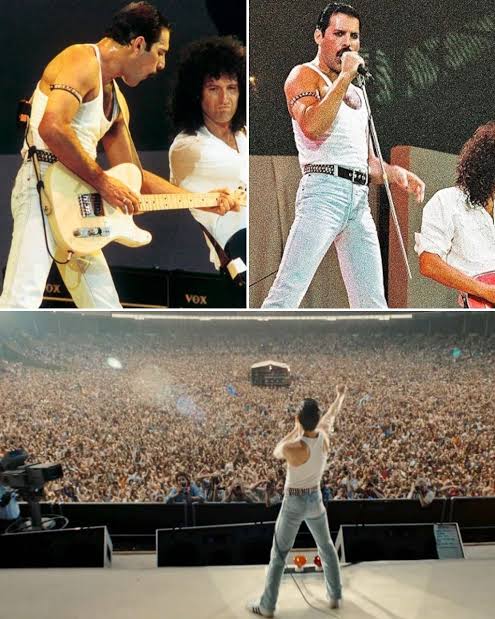QUEEN AT LIVE AID: THE PERFORMANCE THAT DEFINED A GENERATION
On July 13, 1985, something extraordinary happened. Under the blazing London sun, with over 72,000 fans packed into Wembley Stadium and nearly 2 billion more watching across the globe, Queen took the stage at Live Aid—and delivered what would become the most iconic live performance in rock history. In just 20 electrifying minutes, they didn’t just perform. They redefined what it meant to command a stage.
Live Aid was billed as a global concert to raise funds for famine relief in Ethiopia. It featured a lineup of legends—U2, David Bowie, The Who, Elton John, and more—but it was Queen who walked away with the crown. And at the heart of it all was Freddie Mercury, a frontman whose charisma, power, and vocal brilliance turned an already massive event into something transcendent.
From the moment Mercury struck the opening chords of “Bohemian Rhapsody,” it was clear the atmosphere had shifted. This wasn’t just another set in a long day of music. Queen had come to make a statement, and the crowd knew it. What followed was a blistering medley of the band’s greatest hits: “Radio Ga Ga,” “Hammer to Fall,” “We Will Rock You,” and the ultimate anthem, “We Are the Champions.”
But it wasn’t just the song selection that elevated this performance to legendary status. It was the energy, the connection, the moment. Mercury’s voice was in peak form—rich, commanding, effortlessly soaring over Brian May’s scorching guitar riffs and Roger Taylor’s thunderous drums. His now-famous “ay-oh” vocal call-and-response with the crowd wasn’t planned, but it became a defining part of the show. Wembley roared back in perfect sync, echoing his every note like a massive, living instrument.
For those 20 minutes, time stood still. Mercury straddled the line between rock god and everyman, pulling the crowd in with a mixture of flamboyance and intimacy. He didn’t just sing the songs—he lived them, and invited the world to join him. It’s hard to overstate how powerful that connection was, especially in a pre-internet era when such collective experiences were rare and precious.
Queen’s performance wasn’t just about showmanship—it was about heart. They didn’t use elaborate sets or pyrotechnics. They didn’t need to. The energy they unleashed was raw, unfiltered, and deeply human. Watching Mercury prowl the stage in his white tank top and jeans, strutting and stomping with fearless abandon, was like witnessing the embodiment of rock and roll itself.
Behind the scenes, the band had meticulously prepared for Live Aid, trimming their set to the tightest, most impactful hits. But on stage, it felt anything but rehearsed. It felt alive. And that spontaneity, that perfect storm of preparation and instinct, is part of why the performance still gives viewers chills decades later.
Even hardened music critics and skeptical viewers were left speechless. Years later, music publications, historians, and fellow artists continue to cite Queen’s Live Aid set as the pinnacle of live performance. It’s not just a favorite—it’s the gold standard. The moment when a band, a crowd, and a global audience aligned in pure musical ecstasy.
The impact of that performance extended far beyond the stadium. It revitalized Queen’s career, introducing them to a new generation of fans and helping restore their status as global icons. More importantly, it proved that music—real, heartfelt music—could unify people across borders, languages, and backgrounds, even if only for a few unforgettable minutes.
In retrospect, Queen at Live Aid was more than a concert. It was a cultural event, a lightning-in-a-bottle moment that crystallized everything that makes live music so powerful. It wasn’t about ego or excess. It was about connection. About joy. About reminding the world, in the midst of crisis, that we could still come together and sing.
So yes, many great bands played that day. But Queen owned it. Freddie Mercury didn’t just perform; he claimed the stage and made it his kingdom. And in doing so, he gave us not just a show to remember—but a moment that, even 40 years later, still echoes like thunder.
Watch it once, and you’ll be impressed. Watch it again, and you’ll understand why some moments in music aren’t just remembered—they become legend.



